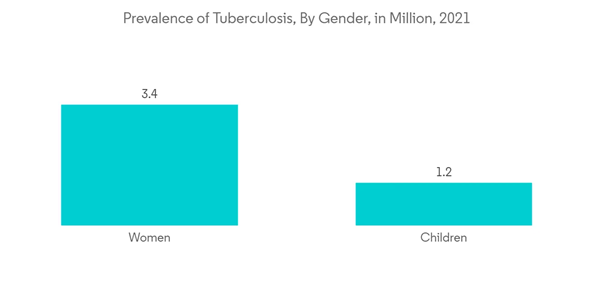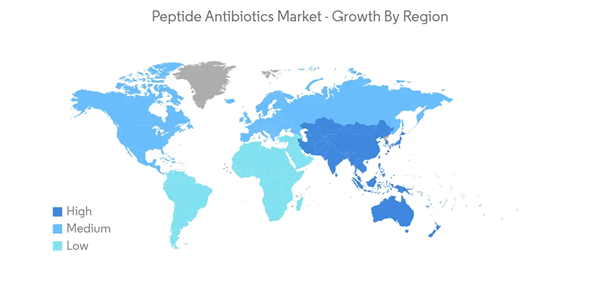The Peptide Antibiotics Market is anticipated to witness steady growth of 5.1% CAGR over the forecast period.
The COVID-19 pandemic had a substantial impact on the peptide antibiotics market initially. The strict lockdowns and government regulations intended to slow down the spread of COVID-19 resulted in a decrease in the number of patient visits and subsequently hampering the number of prescriptions for peptide antibiotics. Various fungal and bacterial infections remained undiagnosed and untreated due to the strict lockdown. During this period outpatient clinics were closed or operating with limited appointments which resulted in a reduction of in-person visits. The number of antibiotic prescriptions was hampered due to the result of the decline in patient visits. According to a research study published in the Infectious Diseases Society of America in October 2021, the total number of outpatient antibiotic prescriptions decreased by 37.1% during March-December 2020 as compared to the prescriptions provided during March-December 2019.
Moreover, the significant increase in the number of patients suffering from antimicrobial resistance significantly hampered the market growth during the COVID-19 period. According to the report published by the Centers for Disease Control and Prevention, more than 29,400 people died from antimicrobial-resistant infections during the first year of the pandemic (2020). Thus, the COVID-19 outbreak affected the market's growth adversely in its preliminary phase; however, the market is expected to gain traction due to the significant increase in the use of telehealth and telemedicine globally.
Further, the increase in the number of product approvals, surge in the number of patients suffering from various infectious diseases and growing adoption of peptide antibiotics in healthcare settings are among the major factors driving the growth of the studied market. This along with the rising number of patients developing antibiotic resistance is also fueling the utilization of peptide antibiotics. According to the report published by European Centre for Disease Prevention and Control (ECDC) in January 2022, every year more than 670,000 cases of infections due to bacteria resistant to antibiotics are registered in European countries and around 33,000 people deaths occur due the antibiotic resistance.
Moreover, the surge in the prevalence of hospital-acquired infections along with the significant increase in skin and bloodstream infections are anticipated to boost the adoption of peptide antibiotics in the management of infection, thereby contributing to the studied market growth. According to the report published by World Health Organization in 2022, every year 8.9 million healthcare-acquired infections occur in acute and long-term facilities across European countries. Moreover, the side effects associated with the use of peptide antibiotics are anticipated to hamper market growth.
Furthermore, the increasing research and development activities for the development of effective peptide antibiotics along with the increasing application areas of non-ribosomal synthesized peptide antibiotics in the management of chronic diseases such as squamous cell carcinoma, testicular carcinoma, and lymphoma is likely to drive the demand of non-ribosomal synthesized peptide antibiotics. For instance, in August 2020, Nanyang Technological University, Singapore, developed a synthetic peptide antibiotic that can treat infection caused by multidrug-resistant bacteria.
Thus, the increasing research and development activities and increasing utilization of non-ribosomal synthesized peptide antibiotics are expected to propel the segmental growth.
New product approvals and highly developed healthcare infrastructure in the United States are some of the factors driving the growth of the peptide antibiotics market in the country. For instance, in March 2021, Melinta Therapeutics announced approval for its new-and-improved formulation of its antibiotic oritavancin in acute bacterial skin and skin structure infections (ABSSSI) caused by susceptible isolates of Gram-positive microorganisms, including Methicillin-resistant Staphylococcus aureus (MRSA). These continuous product launches and approvals in the region are anticipated to drive the growth of the market in the country.
Therefore, owing to the aforesaid factors the growth of the studied market is anticipated in the North America Region.
This product will be delivered within 2 business days.
The COVID-19 pandemic had a substantial impact on the peptide antibiotics market initially. The strict lockdowns and government regulations intended to slow down the spread of COVID-19 resulted in a decrease in the number of patient visits and subsequently hampering the number of prescriptions for peptide antibiotics. Various fungal and bacterial infections remained undiagnosed and untreated due to the strict lockdown. During this period outpatient clinics were closed or operating with limited appointments which resulted in a reduction of in-person visits. The number of antibiotic prescriptions was hampered due to the result of the decline in patient visits. According to a research study published in the Infectious Diseases Society of America in October 2021, the total number of outpatient antibiotic prescriptions decreased by 37.1% during March-December 2020 as compared to the prescriptions provided during March-December 2019.
Moreover, the significant increase in the number of patients suffering from antimicrobial resistance significantly hampered the market growth during the COVID-19 period. According to the report published by the Centers for Disease Control and Prevention, more than 29,400 people died from antimicrobial-resistant infections during the first year of the pandemic (2020). Thus, the COVID-19 outbreak affected the market's growth adversely in its preliminary phase; however, the market is expected to gain traction due to the significant increase in the use of telehealth and telemedicine globally.
Further, the increase in the number of product approvals, surge in the number of patients suffering from various infectious diseases and growing adoption of peptide antibiotics in healthcare settings are among the major factors driving the growth of the studied market. This along with the rising number of patients developing antibiotic resistance is also fueling the utilization of peptide antibiotics. According to the report published by European Centre for Disease Prevention and Control (ECDC) in January 2022, every year more than 670,000 cases of infections due to bacteria resistant to antibiotics are registered in European countries and around 33,000 people deaths occur due the antibiotic resistance.
Moreover, the surge in the prevalence of hospital-acquired infections along with the significant increase in skin and bloodstream infections are anticipated to boost the adoption of peptide antibiotics in the management of infection, thereby contributing to the studied market growth. According to the report published by World Health Organization in 2022, every year 8.9 million healthcare-acquired infections occur in acute and long-term facilities across European countries. Moreover, the side effects associated with the use of peptide antibiotics are anticipated to hamper market growth.
Peptide Antibiotics Market Trends
Non-ribosomal synthesized peptide antibiotics segment is anticipated to Dominate the Market Over the Forecast Period
The non-ribosomal synthesized peptide antibiotics segment is anticipated to hold the largest share of the peptide antibiotics market. The increasing utilization of non-ribosomal synthesized peptide antibiotics such as Gramicidin, Bacitracin, Polymyxin, and Crab tachyplesin in the management of bacterial infections is supporting segment growth. This along with the surge in patients suffering from skin infection is driving the demand for non-ribosomal synthesized peptide antibiotics. Moreover, the increasing number of patients suffering from hospital-acquired infections in developing as well as developed nations are also likely to support the market growth. According to the report published by Organisation for Economic Cooperation and Development (OECD), in 2020, around 3.1 to 4.6 million patients acquire healthcare-associated infection (HAI) each year in acute care hospitals in European countries and it is responsible for around 90,000 deaths every year.Furthermore, the increasing research and development activities for the development of effective peptide antibiotics along with the increasing application areas of non-ribosomal synthesized peptide antibiotics in the management of chronic diseases such as squamous cell carcinoma, testicular carcinoma, and lymphoma is likely to drive the demand of non-ribosomal synthesized peptide antibiotics. For instance, in August 2020, Nanyang Technological University, Singapore, developed a synthetic peptide antibiotic that can treat infection caused by multidrug-resistant bacteria.
Thus, the increasing research and development activities and increasing utilization of non-ribosomal synthesized peptide antibiotics are expected to propel the segmental growth.
North America is Expected to Dominate the Peptide Antibiotics Market
North America is expected to dominate the market owing to factors such as the growing incidences of skin infections, and the presence of key players in the region. An increase in the number of patients suffering from hospital-acquired infections in the United States is among the key factors which contribute to the growth of the studied market in North America. According to the research article published by the American Academy of Dermatology Association in April 2022, 197,700 new cases of melanoma, 97,920 noninvasive and 99,780 invasives, will be diagnosed in the U.S. in 2022. Moreover, according to the same source nonmelanoma skin cancer (NMSC), including basal cell carcinoma (BCC) and squamous cell carcinoma (SCC), affects more than 3 million Americans a year.New product approvals and highly developed healthcare infrastructure in the United States are some of the factors driving the growth of the peptide antibiotics market in the country. For instance, in March 2021, Melinta Therapeutics announced approval for its new-and-improved formulation of its antibiotic oritavancin in acute bacterial skin and skin structure infections (ABSSSI) caused by susceptible isolates of Gram-positive microorganisms, including Methicillin-resistant Staphylococcus aureus (MRSA). These continuous product launches and approvals in the region are anticipated to drive the growth of the market in the country.
Therefore, owing to the aforesaid factors the growth of the studied market is anticipated in the North America Region.
Peptide Antibiotics Market Competitor Analysis
The peptide antibiotics market is Moderately fragmented in nature due to the presence of several companies operating globally as well as regionally. The competitive landscape includes an analysis of a few international as well as local companies which hold market shares and are well known. include Merck & Co., Inc., Monarch Pharmachem, ANI Pharmaceuticals, Inc., Melinta Therapeutics, AbbVie, Cumberland Pharmaceuticals Inc., and Xellia Pharmaceuticals among others.Additional benefits of purchasing the report:
- The market estimate (ME) sheet in Excel format
- 3 months of analyst support
This product will be delivered within 2 business days.
Table of Contents
1 INTRODUCTION
4 MARKET DYNAMICS
5 MARKET SEGMENTATION (Market Size by Value - USD million)
6 COMPETITIVE LANDSCAPE
Companies Mentioned (Partial List)
A selection of companies mentioned in this report includes, but is not limited to:
- Merck & Co., Inc.
- Monarch Pharmachem
- ANI Pharmaceuticals, Inc.
- Melinta Therapeutics.
- AbbVie
- Cumberland Pharmaceuticals Inc.
- Xellia Pharmaceuticals
- JHP Pharmaceuticals, LLC
- Sandoz AG
- GSK plc.
Methodology

LOADING...










